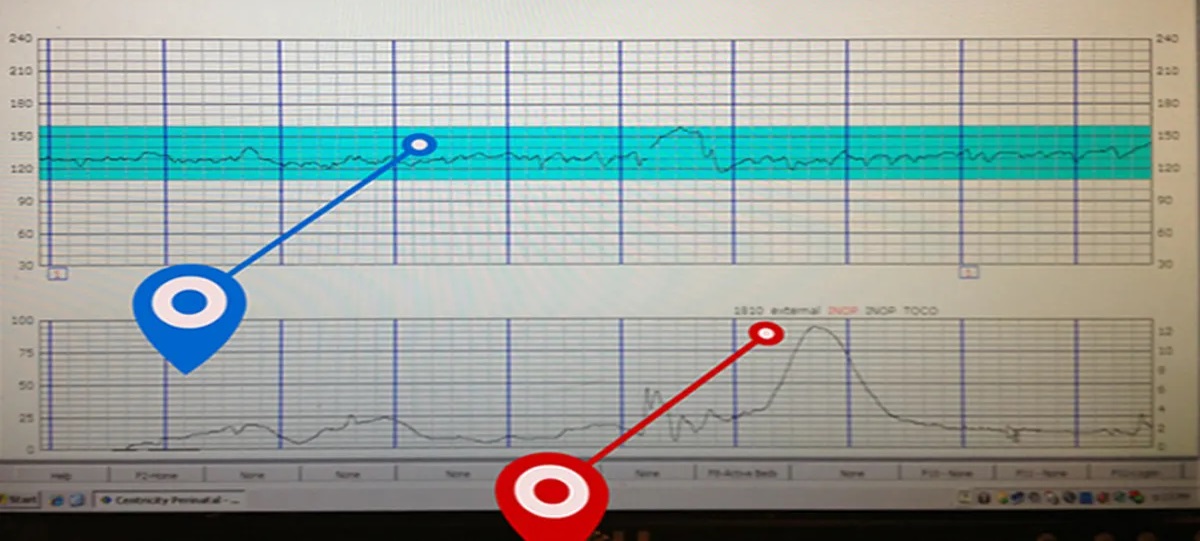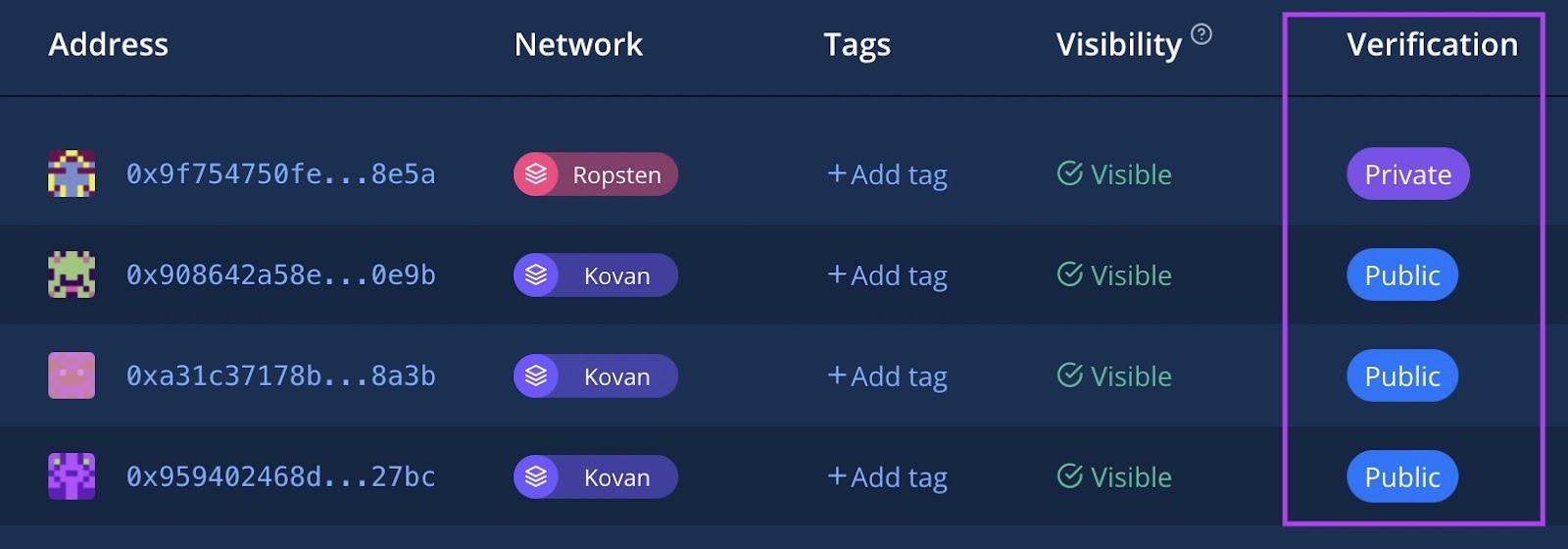Introduction
Welcome to the fascinating world of monitoring contractions! If you’ve ever wondered what those fluctuating lines on a monitor mean during pregnancy or labor, you’re in the right place.
Contractions are a crucial aspect of the labor process, signaling the initiation and progression of childbirth. Monitoring these contractions is essential to ensure the well-being of both the mother and the baby. By closely observing the patterns and intensity of contractions, healthcare professionals can make informed decisions regarding the management of labor and delivery.
In this article, we will explore what contractions are, why monitoring them is important, and how they are visually represented on a monitor. By the end, you’ll have a better understanding of this vital aspect of the labor process.
Monitoring contractions not only provides healthcare providers with valuable information but also empowers mothers, allowing them to actively participate in their childbirth experience. It offers reassurance, enabling healthcare professionals to intervene if necessary or provide supportive measures to enhance the progression of labor.
So, whether you’re an expectant mother eager to learn more about the process or a healthcare professional seeking to deepen your knowledge, let’s embark on this journey to unravel the mystery of contractions on a monitor.
What Are Contractions
Contractions are rhythmic tightening and releasing of the uterine muscles during pregnancy and labor. They play a pivotal role in the journey of childbirth, as they help the cervix efface (thin out) and dilate (open), ultimately leading to the delivery of the baby.
These muscular contractions are caused by the release of the hormone oxytocin. Oxytocin is produced by the pituitary gland and stimulates the uterus to contract. As the contractions increase in frequency, intensity, and duration, they gradually guide the baby down the birth canal.
Contractions during pregnancy, also known as Braxton Hicks contractions or “practice contractions,” typically start in the second or third trimester. These contractions are sporadic, irregular, and often painless. They serve as a way for the uterus to prepare for labor by toning the uterine muscles and increasing blood flow to the placenta.
On the other hand, contractions during labor are more regular, intense, and painful. They signify the onset of active labor and indicate that the baby’s arrival is imminent. These contractions work in a coordinated pattern, pushing the baby downwards and causing the cervix to progressively open.
During the latent phase of labor, contractions may occur at irregular intervals and last for shorter durations. As labor progresses into the active phase, contractions become more intense, lasting longer and occurring at regular intervals. The transition phase typically brings the most intense contractions as the body prepares for the final stage of childbirth.
Understanding what contractions are is fundamental to comprehending their significance in the labor process. By monitoring contractions, healthcare providers can assess the progress of labor and make informed decisions to ensure the safety and well-being of both the mother and the baby.
The Purpose of Monitoring Contractions
Monitoring contractions is a crucial aspect of obstetric care during labor and delivery. The primary purpose is to assess the progress of labor and ensure the well-being of both the mother and the baby. By closely monitoring contractions, healthcare providers can gather valuable information that guides their decision-making in managing childbirth.
One of the key objectives of monitoring contractions is to determine the strength and intensity of the contractions. This information helps healthcare providers gauge the effectiveness of contractions in promoting cervical dilation and the descent of the baby through the birth canal. It aids in identifying any abnormalities or issues that may hinder progress and enables healthcare providers to intervene or adjust the labor management plan accordingly.
Monitoring contractions also allows for the assessment of the frequency and duration of contractions. By tracking these patterns, healthcare providers can detect any irregularities or deviations from the expected progress of labor. In cases where contractions are too frequent or too infrequent, or if they are of inadequate duration, healthcare providers can take appropriate action to ensure the labor progresses smoothly and safely.
In addition to evaluating the progress of labor, monitoring contractions aids in assessing the baby’s well-being. Contractions play a role in the blood supply to the placenta and the baby. By monitoring uterine activity, healthcare providers can ensure that the baby is receiving an adequate oxygen supply during contractions and determine if any intervention is necessary to safeguard the baby’s health.
Moreover, monitoring contractions provides valuable information for pain management during labor. Contractions can cause significant discomfort and pain for the mother. By closely monitoring the intensity and frequency of contractions, healthcare providers can ensure appropriate pain relief measures are administered, according to the mother’s individual needs and preferences.
Overall, the purpose of monitoring contractions is to gather essential data to inform healthcare providers about the progress of labor, the baby’s well-being, and the management of pain. This data allows them to make informed decisions, provide necessary interventions, and ensure a safe and positive childbirth experience for both the mother and baby.
What to Expect During a Contraction
Experiencing contractions during labor can be an intense and sometimes challenging process for expectant mothers. Understanding what to expect during a contraction can help prepare and navigate through this stage of childbirth.
Onset: Contractions typically start gradually, with a gradual buildup of intensity. Initially, they may feel like mild menstrual cramps or lower back discomfort. As labor progresses, contractions become stronger and more intense.
Rhythm: Contractions follow a specific pattern or rhythm. They have a distinct beginning, peak, and then gradually fade away. The entire duration of a contraction can vary, but on average, they last between 30-60 seconds.
Peak Intensity: The peak of a contraction is the point of maximum intensity. During this time, the pain and pressure may be the most intense. It is important to remember that the intense phase is temporary and will subside as the contraction starts to decrease in intensity.
Location: Contractions may be felt as a tightening sensation in the lower abdomen or as pressure in the lower back. The location can vary for each woman, depending on the position of the baby and individual body structure.
Interval: As labor progresses, contractions become more frequent and closer together. In the early stages, there may be longer intervals between contractions, giving the mother time to rest and recover. However, as labor advances, the intervals shorten, and contractions may feel more continuous.
Intensity: The intensity of contractions varies from woman to woman and throughout the different stages of labor. The intensity is often described as a strong, tightening sensation, accompanied by pressure and discomfort. Some women may experience more intense contractions during active labor and the transition phase.
Importantly, it is essential to remember that each woman’s experience with contractions is unique. The perception of pain and sensations may vary, and the intensity and duration of contractions may differ. Effective pain management techniques, such as breathing exercises, relaxation techniques, and medication, can be employed to help cope with the discomfort.
Learning what to expect during a contraction can provide a sense of readiness and empowerment during the labor process. By working closely with healthcare providers and utilizing pain management techniques, expectant mothers can navigate through contractions and move closer to the joyous moment of welcoming their baby into the world.
How Are Contractions Monitored
Monitoring contractions is a crucial part of caring for pregnant women during labor and delivery. By monitoring contractions, healthcare providers can assess the progress of labor and ensure the well-being of both the mother and the baby. There are various methods and tools used to monitor contractions, both externally and internally, depending on the specific needs and circumstances. Let’s explore some of the common methods of monitoring contractions.
External Monitoring: External monitoring is a non-invasive method that involves placing sensors on the mother’s abdomen.
Tocodynamometer: Tocodynamometer is a monitoring tool that measures the frequency and duration of contractions. It consists of a strap placed around the mother’s abdomen, with a sensor that detects the changes in uterine activity.
Ultrasound Transducer: An ultrasound transducer is also placed on the mother’s abdomen to monitor contractions. It uses sound waves to detect the changes in the uterus and provides a visual representation of the contractions.
Internal Monitoring: In certain situations, internal monitoring may be necessary to obtain more accurate and precise data on contractions.
Intrauterine Pressure Catheter: This method involves the insertion of a small catheter through the cervix and into the uterus to measure the pressure exerted by the contractions directly.
Fetal Scalp Electrode: In addition to monitoring contractions, a fetal scalp electrode may be used to assess the baby’s heart rate. It is inserted through the cervix and attached to the baby’s scalp to provide continuous monitoring of the fetal heart rate during contractions.
The choice of monitoring method depends on various factors such as the stage of labor, the mother’s condition, the need for continuous monitoring, and any specific concerns or complications. Healthcare providers carefully assess these factors to determine the most appropriate method of monitoring contractions for each individual case.
It is important to note that the monitoring process is safe and performed by trained healthcare professionals. The information gathered from monitoring contractions helps healthcare providers make informed decisions about the progress of labor, the well-being of the baby, and the management of pain.
By employing these monitoring techniques, healthcare providers can carefully track and evaluate contractions, ensuring the best possible care for both the mother and the baby during the labor and delivery process.
External Monitoring
External monitoring is a non-invasive method used to monitor contractions during labor and delivery. It involves placing sensors on the mother’s abdomen to gather information about the frequency, duration, and intensity of contractions. External monitoring provides valuable data to healthcare providers, helping them assess the progress of labor and ensure the well-being of both the mother and the baby.
There are two primary tools used for external monitoring: the tocodynamometer and the ultrasound transducer.
Tocodynamometer: The tocodynamometer is a device that measures uterine activity by detecting changes in pressure on the mother’s abdomen. It consists of a strap that is placed around the mother’s abdomen and connected to a monitoring device. The tocodynamometer can accurately record the frequency and duration of contractions, providing a graphical representation of the uterine activity. This information helps healthcare providers monitor the progress of labor and make informed decisions about the management of childbirth.
Ultrasound Transducer: The ultrasound transducer is another tool used for external monitoring of contractions. It uses high-frequency sound waves to detect changes in the uterus and provides a visual representation of the contractions. The transducer is placed on the mother’s abdomen, usually over the area where the strongest contractions are felt. It can precisely measure the intensity and frequency of contractions, allowing healthcare providers to monitor the progress of labor and ensure that the contractions are effectively promoting cervical dilation and descent of the baby.
External monitoring is a safe and non-invasive method that does not cause any discomfort or harm to the mother or the baby. It allows for continuous monitoring of contractions during labor, providing valuable data for healthcare providers to make informed decisions about the management of labor and delivery.
There are certain factors to consider when using external monitoring. Body movement or repositioning by the mother can sometimes affect the accuracy of the readings. In such cases, healthcare providers may need to adjust the positioning of the sensors or use alternative monitoring methods. Additionally, in cases where there are concerns about the accuracy of the readings or a need for more precise data, healthcare providers may opt for internal monitoring techniques.
Overall, external monitoring is a commonly used and effective method for monitoring contractions during labor. It provides valuable information to healthcare providers, helping them ensure the well-being of both the mother and the baby throughout the labor and delivery process.
Tocodynamometer
The tocodynamometer is a device commonly used for external monitoring of contractions during labor. It plays a vital role in assessing and tracking uterine activity to ensure the progress of labor and the well-being of both the mother and the baby.
The tocodynamometer consists of a specialized belt or strap that is placed around the mother’s abdomen, typically above the uterus. The belt contains pressure sensors that detect changes in pressure caused by uterine contractions. These sensors are connected to a monitoring device that records and displays the data collected from the contractions.
When the uterine muscles contract during labor, the pressure exerted on the abdomen increases. The tocodynamometer detects these changes in pressure and translates them into a graph or waveform that represents the contractions. This information is essential for healthcare providers to monitor the frequency, duration, and intensity of contractions throughout labor.
The tocodynamometer provides several key benefits in monitoring contractions. First, it allows healthcare providers to accurately measure the frequency of contractions. By observing the time intervals between contractions, they can determine whether labor is progressing in a steady and consistent manner.
Second, the duration of each contraction is recorded, providing insights into the length of time the uterus contracts and how long the mother experiences the contraction. This information helps healthcare providers assess the strength and effectiveness of the contractions in promoting cervical dilation and descent of the baby.
In addition, the tocodynamometer measures the intensity of contractions. The device can quantify the strength of the contractions, giving healthcare providers a clear understanding of the force exerted by the uterine muscles. This information helps determine the adequacy of the contractions to progress labor and facilitates decisions regarding pain management techniques and interventions if necessary.
The data provided by the tocodynamometer is displayed as a graph or waveform on the monitoring device, allowing healthcare providers to visually assess the pattern and variations in contractions. They can identify irregularities or abnormalities in the contractions and take appropriate action to ensure the well-being of the mother and the baby.
The tocodynamometer is a safe and non-invasive method that does not cause discomfort or harm to the mother or the baby. The device can be easily adjusted to ensure accurate and consistent readings throughout labor. However, it is important to note that the tocodynamometer relies on external measurements and may provide slightly less accurate information compared to internal monitoring methods.
Overall, the tocodynamometer is a valuable tool in monitoring contractions during labor. It provides essential data on the frequency, duration, and intensity of contractions, enabling healthcare providers to make informed decisions and provide appropriate care to ensure a safe and healthy delivery.
Ultrasound Transducer
The ultrasound transducer is a commonly used tool for monitoring contractions during labor. It provides real-time visualization of uterine activity, allowing healthcare providers to assess the progress of labor and ensure the well-being of both the mother and the baby.
The ultrasound transducer consists of a handheld device that emits high-frequency sound waves. The transducer is placed on the mother’s abdomen, typically over the area where the strongest contractions are felt. These sound waves penetrate the abdominal wall and reflect off the uterine muscle, creating a visual representation of the contractions.
By using the ultrasound transducer, healthcare providers can effectively monitor the intensity, frequency, and duration of contractions. The device enables them to see the wave-like pattern produced by the contracting uterine muscle on a graphical display.
The ultrasound transducer provides valuable information about the strength or intensity of contractions. It allows healthcare providers to quantify the force or pressure exerted by the uterine muscles during each contraction. These intensity measurements help healthcare providers determine the effectiveness of contractions in promoting cervical dilation and the descent of the baby.
In addition to intensity, the ultrasound transducer provides accurate data regarding the frequency and duration of contractions. The device captures the time intervals between contractions and the length of each contraction, ensuring that labor is progressing as expected.
Visualizing contractions through the ultrasound transducer allows healthcare providers to observe the pattern and variations in uterine activity. They can identify irregular contractions or inadequate rest between contractions, which may require medical intervention or adjustments in the management of labor.
One advantage of the ultrasound transducer is the ability to simultaneously monitor the baby’s heart rate through a process called electronic fetal monitoring (EFM). Healthcare providers can assess the fetal heart rate in relation to the contractions, providing a comprehensive understanding of the baby’s well-being during labor.
The ultrasound transducer is a safe and non-invasive method of monitoring contractions. It does not pose any risk to the mother or the baby and is easily adjustable to obtain optimal readings. However, it should be noted that the accuracy and reliability of the ultrasound transducer may be influenced by factors such as maternal obesity, baby’s position, or maternal movement.
In summary, the ultrasound transducer is a valuable tool in monitoring contractions during labor. It provides real-time visualization of uterine activity, allowing healthcare providers to assess the frequency, duration, and intensity of contractions. With this information, they can make informed decisions and provide appropriate care to ensure the well-being of both the mother and the baby throughout the labor and delivery process.
Internal Monitoring
In certain situations, healthcare providers may choose to use internal monitoring methods to obtain more accurate and precise data on contractions during labor. Internal monitoring involves placing monitoring devices directly into the uterus or on the baby’s scalp to closely assess uterine activity and the baby’s well-being.
There are two common methods of internal monitoring: the intrauterine pressure catheter (IUPC) and the fetal scalp electrode.
Intrauterine Pressure Catheter (IUPC): The IUPC is a thin, flexible catheter that is inserted through the cervix and placed inside the uterus. It measures the pressure exerted by the uterine contractions directly. The IUPC provides highly accurate readings of the strength, frequency, and duration of contractions, allowing healthcare providers to closely monitor the progress of labor.
Fetal Scalp Electrode: The fetal scalp electrode is a small electrode attached to a wire. It is gently pressed against the baby’s scalp during labor. The electrode picks up the electrical signals of the baby’s heart rate and provides continuous monitoring of the fetal heart rate during contractions. This method allows for a more precise assessment of the baby’s well-being in relation to contractions.
Internal monitoring provides several advantages over external monitoring methods. It offers a more accurate and direct measurement of the intensity of contractions, as the measurement is taken directly from inside the uterus. This information is crucial for healthcare providers to assess the effectiveness of contractions in promoting labor progress.
Additionally, internal monitoring has the advantage of providing continuous and uninterrupted data. Unlike external monitoring, which may be affected by maternal movement or repositioning, internal monitoring methods are not impacted by external factors. This allows healthcare providers to gather consistent and reliable information on contractions throughout labor.
It is important to note that internal monitoring is typically reserved for specific situations, such as high-risk pregnancies or when more precise data is needed. The decision to use internal monitoring methods is made on an individual basis, taking into consideration factors such as the mother’s condition, the progress of labor, and the baby’s well-being.
While internal monitoring methods do carry a small risk of infection or discomfort, they are generally safe and well-tolerated when performed by trained healthcare professionals. The benefits of obtaining accurate and precise data often outweigh the potential risks.
Overall, internal monitoring provides healthcare providers with more detailed information about contractions and the baby’s well-being during labor. By utilizing these methods, healthcare professionals can make informed decisions and provide appropriate care to ensure a safe and successful delivery.
Intrauterine Pressure Catheter
The intrauterine pressure catheter (IUPC) is a monitoring device used during labor and delivery to measure the pressure exerted by uterine contractions. It is a valuable tool that provides healthcare providers with precise and accurate data on the strength, frequency, and duration of contractions, allowing them to closely monitor and manage the progress of labor.
The IUPC is a thin and flexible catheter that is inserted through the cervix and placed inside the uterus. Once in place, it measures the pressure changes within the uterine cavity during contractions. The IUPC is connected to a monitoring device that displays the contraction patterns and provides a graphical representation of uterine activity.
By measuring the pressure exerted by contractions, the IUPC allows healthcare providers to assess the strength of the contractions. This information is crucial in determining whether the contractions are effective in promoting cervical dilation and the descent of the baby. It provides a more accurate and direct measurement of contraction strength compared to external monitoring methods.
The IUPC also provides information on the frequency and duration of contractions. Healthcare providers can observe the time between contractions and the length of each contraction, helping them determine the progress of labor and make informed decisions regarding pain management and interventions if necessary.
One of the advantages of the IUPC is its ability to provide continuous and uninterrupted monitoring of contractions. Unlike external monitoring methods, which may be affected by maternal movement or repositioning, the IUPC maintains a consistent and reliable record of uterine activity throughout labor.
The IUPC can also be used in combination with other forms of internal monitoring, such as the fetal scalp electrode, to obtain a comprehensive understanding of both the mother’s contractions and the baby’s heart rate during labor. This allows healthcare providers to assess the relationship between fetal well-being and uterine activity.
The insertion of the IUPC is a minimally invasive procedure performed by trained healthcare professionals. While there is a small risk of infection or discomfort associated with its placement, the benefits of the IUPC, providing accurate and precise data on contractions, often outweigh the potential risks.
It is important to note that the decision to use the IUPC is made on an individual basis, taking into consideration factors such as the mother’s condition, the progress of labor, and the need for continuous and accurate monitoring. Healthcare providers carefully evaluate the benefits and risks to ensure the best possible care for the mother and the baby.
In summary, the intrauterine pressure catheter is a valuable tool in monitoring contractions during labor. It provides precise and reliable data on the strength, frequency, and duration of contractions, allowing healthcare providers to closely monitor the progress of labor and make informed decisions to ensure a safe and successful delivery.
Fetal Scalp Electrode
The fetal scalp electrode is a commonly used component in internal monitoring during labor and delivery. It provides healthcare providers with continuous and direct measurements of the baby’s heart rate in relation to uterine contractions. This valuable information helps healthcare providers assess the baby’s well-being and make informed decisions regarding the management of labor.
The fetal scalp electrode is a small electrode attached to a thin wire. It is gently applied to the baby’s scalp during labor, usually after the cervix is sufficiently dilated. The electrode is designed to pick up the electrical signals produced by the baby’s heart, allowing for continuous monitoring of the fetal heart rate.
The placement of the fetal scalp electrode is a safe and minimally invasive procedure performed by trained healthcare professionals. After placement, the electrode connects to a monitoring device, which displays the baby’s heart rate and provides real-time information during contractions.
The fetal scalp electrode offers several advantages in monitoring contractions and fetal heart rate. It provides accurate and immediate data, ensuring that healthcare providers have continuous and precise information about the baby’s well-being. This allows for prompt identification of any changes or signs of distress that may require further intervention.
By observing the fetal heart rate patterns in relation to uterine contractions, healthcare providers can assess the baby’s response and tolerance to labor. They can identify patterns of fetal distress or abnormalities that may indicate the need for additional interventions or adjustments in the management of labor.
In addition to the continuous monitoring of the fetal heart rate, the fetal scalp electrode enables healthcare providers to evaluate the variability and changes in the heart rate throughout labor. Variations in the heart rate provide important information about the baby’s neurological well-being and response to uterine contractions.
The fetal scalp electrode can be used in combination with other forms of internal monitoring, such as the intrauterine pressure catheter (IUPC). This comprehensive monitoring approach allows healthcare providers to assess both uterine contractions and fetal heart rate simultaneously, gaining a deeper understanding of the labor progress and the baby’s well-being.
It is important to mention that the placement of the fetal scalp electrode does carry a small risk of infection and discomfort. However, these risks are typically outweighed by the benefits of continuous monitoring and the valuable data it provides for the management of labor.
In summary, the fetal scalp electrode is a valuable tool in the internal monitoring of labor. It provides healthcare providers with continuous and direct measurements of the baby’s heart rate, allowing for real-time assessment of fetal well-being. By closely monitoring the fetal heart rate in relation to contractions, healthcare providers can make informed decisions and provide appropriate care to ensure a safe and successful delivery.
What Do Contractions Look Like On a Monitor
Contractions on a monitor are visually represented as graphical patterns that depict the changes in uterine activity during labor. These patterns provide valuable information to healthcare providers about the frequency, duration, and intensity of contractions, allowing them to assess the progress of labor and the well-being of both the mother and the baby.
Uterine Activity Patterns:
The graphical representation of contractions typically shows a pattern of peaks and valleys, representing the contracting and relaxing phases of the uterine muscles. These patterns form distinct waves or curves on the monitor that rise and fall in intensity and duration.
Baseline Contractions:
The baseline represents the resting state of the uterus between contractions. It is the level at which the uterine muscles are relaxed and not contracting. The portion of the pattern below the baseline indicates the resting tone of the uterus.
Peak Contraction Intensity:
The peaks in the contraction pattern represent the highest point of intensity during each contraction. The height and steepness of these peaks indicate the strength or intensity of the contractions. Healthcare providers can assess whether the contractions are strong and effective in promoting labor progress.
Resting Tone:
The portion of the pattern below the baseline and between contractions represents the resting tone of the uterus. It provides information about the relaxation and recovery of the uterine muscles between contractions, indicating the readiness for the next contraction.
Visualization Techniques:
Technological advancements have introduced various visualization techniques to enhance the monitoring of contractions. These techniques may include color-coded displays, 3D representations, or numerical values that provide additional information about the contractions and their characteristics.
Contractions on a monitor can be visualized in different ways, depending on the specific monitoring device and system used. The graphical patterns and visual representations offer healthcare providers a comprehensive view of uterine activity, allowing them to identify irregularities or abnormalities that may require intervention or further assessment.
It is important to note that while the monitor display provides valuable information, it is essential for healthcare providers to interpret the patterns in the context of each individual case. They take into account factors such as the mother’s progress, the baby’s heart rate, and other clinical observations to make informed decisions regarding the management of labor and the well-being of both the mother and the baby.
In summary, contractions on a monitor are visually represented as graphical patterns that depict the changes in uterine activity during labor. These patterns provide healthcare providers with essential information about the frequency, duration, and intensity of contractions, allowing them to assess the progress of labor and ensure the well-being of both the mother and the baby.
Uterine Activity Patterns
Uterine activity patterns are the visual representation of contractions on a monitor during labor. These patterns provide healthcare providers with valuable information about the progression, intensity, and duration of contractions, allowing them to assess the labor process and make informed decisions regarding the management of childbirth.
The graphical representation of uterine contractions typically appears as a series of peaks and valleys that form distinct waves or curves on the monitor. These patterns reflect the contracting and relaxing phases of the uterine muscles as labor progresses.
Each contraction is represented by a rising and falling curve on the monitor, with distinctive characteristics that can be observed and analyzed by healthcare providers:
– Frequency: The horizontal spacing between each curve represents the frequency of contractions. It is measured as the time interval between the start of one contraction to the start of the next. By assessing the frequency, healthcare providers can determine if contractions are occurring at regular intervals, which is indicative of a progressing labor.
– Duration: The horizontal length or width of each curve represents the duration of a contraction. It measures how long each contraction lasts from the start to the end. Healthcare providers monitor the duration to ensure that contractions are of adequate length to effectively promote cervical dilation and the descent of the baby.
– Intensity: The height and steepness of each peak indicate the intensity or strength of a contraction. The higher the peak, the more intense the contraction. Healthcare providers closely monitor the intensity of contractions to assess their effectiveness in advancing labor and facilitating the birth process.
Uterine activity patterns allow healthcare providers to observe the overall progress of labor and identify any irregularities or abnormalities that may require intervention or further evaluation. They can visually determine if contractions are occurring consistently, becoming stronger, and increasing in frequency as labor advances.
Additionally, healthcare providers analyze the patterns in conjunction with other clinical observations, such as the mother’s level of pain, cervical dilation, and the baby’s heart rate, to gain a comprehensive understanding of the labor process and make appropriate decisions regarding pain management, labor augmentation, or the need for medical interventions.
It’s important to note that each woman may have unique contraction patterns, and variations can occur based on individual factors, such as the shape and size of the uterus, the position of the baby, and the mother’s response to labor. Therefore, healthcare providers interpret the uterine activity patterns within the specific context of each laboring woman.
In summary, uterine activity patterns displayed on a monitor provide healthcare providers with visual insights into the frequency, duration, and intensity of contractions during labor. These patterns help guide decisions regarding pain management, interventions, and the overall management of childbirth, ensuring the well-being of both the mother and the baby.
Baseline Contractions
Baseline contractions are an important component of the uterine activity patterns observed on a monitor during labor. They serve as a reference point for healthcare providers to assess the resting state of the uterus and monitor changes in contractions throughout the labor process.
The baseline represents the period between contractions when the uterine muscles are relaxed and not actively contracting. It is the point at which the contraction pattern returns to a steady and consistent level before the next contraction begins.
Baseline contractions are visually shown on the monitor as the portion of the pattern below the peaks, representing the resting tone of the uterus. The horizontal line or level that indicates the baseline helps healthcare providers track the changes in contractions and evaluate the progress of labor.
By observing the baseline contractions, healthcare providers can assess several important factors:
– Resting Tone: The amplitude or height of the baseline contractions indicates the resting tone of the uterus. It provides information about the relaxation of the uterine muscles between contractions, reflecting the readiness for the next contraction to occur. Healthcare providers monitor the resting tone to ensure that the uterus is adequately resting and recovering between contractions.
– Irregularities: Baseline contractions can help identify irregularities in the contraction pattern. Any deviation from a consistent baseline could indicate issues such as incoordination of uterine activity, inadequate rest between contractions, or uterine hyperstimulation. These irregularities may require intervention or further evaluation by healthcare providers.
The baseline contractions are analyzed in context with other components of the uterine activity patterns, such as the frequency, duration, and intensity of contractions. This comprehensive evaluation allows healthcare providers to make informed decisions about pain management, interventions, or adjustments in the management of labor based on the progress and rhythm of contractions.
It is important to note that the baseline contractions can vary among laboring women and throughout different stages of labor. Factors such as maternal position, activity level, or pain management techniques may influence the resting tone of the uterus. Additionally, observations of the baseline contractions need to be considered alongside other clinical assessments, such as cervical dilation, the mother’s level of pain, and the baby’s heart rate, to gain a complete picture of labor progress.
In summary, baseline contractions provide healthcare providers with valuable insights into the resting state of the uterus during labor. By monitoring changes in the baseline contractions, healthcare providers can assess the relaxation and recovery between contractions and make informed decisions regarding the management of labor and the well-being of both the mother and the baby.
Peak Contraction Intensity
Peak contraction intensity is a key aspect of uterine activity patterns observed on a monitor during labor. It provides valuable information to healthcare providers about the strength and intensity of contractions, allowing them to assess the progress of labor and the effectiveness of contractions in promoting cervical dilation and the descent of the baby.
Peak contraction intensity is visually represented on the monitor as the highest point or peak of each contraction. The height and steepness of these peaks indicate the strength of the contractions. The greater the peak, the more intense the contraction is.
Healthcare providers closely monitor the peak contraction intensity to evaluate several important factors:
– Strength of Contractions: Peak contraction intensity provides an indication of the force exerted by the uterine muscles during each contraction. Strong and intense contractions are essential for promoting cervical dilation and advancing labor. Monitoring the peak intensity allows healthcare providers to determine if contractions are sufficient and effective in achieving labor progress.
– Labor Progress: By assessing the peak contraction intensity, healthcare providers can evaluate if contractions are becoming stronger and more intense as labor progresses. Increasing intensity indicates a positive trend in labor advancement. It helps guide decisions on pain management, interventions, and the overall management of labor.
– Adequacy of Contractions: Peak contraction intensity is considered alongside other components of uterine activity patterns, such as frequency, duration, and resting tone, to assess the overall adequacy of contractions. If contractions are consistently strong and intense, healthcare providers gain confidence in the effectiveness of labor and the achievement of adequate cervical dilation.
It’s important to note that peak contraction intensity may vary among laboring women and throughout different stages of labor. Each woman’s pain threshold, uterine responsiveness, and individual factors influence the perceived intensity of contractions. Additionally, assessment of peak intensity is evaluated in conjunction with other clinical observations, such as the mother’s progress, the baby’s heart rate, and overall labor experience.
Monitoring peak contraction intensity allows healthcare providers to make informed decisions regarding pain management, labor augmentation, or the need for medical interventions. They can provide appropriate support and intervention if contractions are not adequately promoting labor progress or if additional pain management measures are needed.
In summary, peak contraction intensity provides valuable information to healthcare providers during labor. This aspect of uterine activity patterns assists in assessing the strength and effectiveness of contractions, evaluating labor progress, and making informed decisions regarding pain management and interventions. By closely monitoring peak intensity, healthcare providers can ensure the well-being of both the mother and the baby throughout the labor and delivery process.
Resting Tone
Resting tone is an essential component of the uterine activity patterns observed on a monitor during labor. It provides healthcare providers with valuable insights into the relaxation and recovery phase of the uterine muscles between contractions, allowing them to assess the overall progress of labor and make informed decisions regarding pain management and interventions.
Resting tone is visually represented on the monitor as the portion of the pattern below the baseline and between contractions. It indicates the level at which the uterine muscles are relaxed and not actively contracting. The amplitude or height of the resting tone provides information about the degree of relaxation during the resting phase.
Healthcare providers closely monitor the resting tone to evaluate several important factors:
– Recovery between Contractions: The resting tone reflects the ability of the uterine muscles to recover and relax between contractions. A lower resting tone indicates a higher degree of relaxation, allowing the uterus to rest and prepare for the next contraction. Adequate recovery is important for the overall progress of labor and the well-being of both the mother and the baby.
– Adequacy of Rest: The duration and quality of rest between contractions are essential for the effectiveness of labor. The resting tone provides information on the uterus’s ability to rest between contractions, which is important for maintaining the strength and intensity of subsequent contractions. Adequate rest ensures that the mother’s energy is preserved and that the uterus remains ready for effective contractions.
– Uterine Hyperstimulation: Monitoring the resting tone allows healthcare providers to identify any signs of uterine hyperstimulation, which occurs when contractions occur too frequently or with excessive intensity, leaving little time for the uterus to rest. Uterine hyperstimulation can cause complications and may require interventions to restore a balance and ensure the well-being of both the mother and the baby.
Understanding the resting tone helps healthcare providers determine the overall health and readiness of the uterus for effective contractions. It allows them to make informed decisions regarding pain management, labor augmentation, or the need for medical interventions such as uterine relaxants or adjustments in medication dosage.
It is important to note that resting tone can vary among laboring women and throughout different stages of labor. Factors such as maternal position, activity level, or pain management techniques may influence the resting tone of the uterus. Assessing the resting tone is done in conjunction with other clinical assessments, such as cervical dilation, contractions’ intensity, and the baby’s heart rate, to gain a comprehensive understanding of labor progress.
In summary, monitoring the resting tone provides healthcare providers with important information about the relaxation and recovery phase of the uterus between contractions during labor. By evaluating the quality and adequacy of rest, healthcare providers can make informed decisions to optimize the effectiveness of contractions and ensure the well-being of both the mother and the baby throughout the labor and delivery process.
Visualization Techniques
Visualization techniques in monitoring contractions provide healthcare providers with enhanced ways to assess and understand uterine activity during labor. These techniques employ various methods to represent contractions visually, offering additional insights and aiding in the evaluation of labor progress and the well-being of both the mother and the baby.
Some common visualization techniques include:
– Color-Coded Displays: These displays use different colors to represent the intensity or strength of contractions. Lighter colors may indicate milder contractions, while darker or brighter colors may represent more intense contractions. Color-coded displays provide a quick visual assessment of the intensity of contractions over time.
– 3D Representations: Three-dimensional representations of contractions provide a multidimensional view of uterine activity patterns. These visualizations show the fluctuating intensity and frequency of contractions, giving healthcare providers a clearer understanding of the dynamics of labor.
– Numerical Values: Some monitoring systems provide numerical values that indicate the frequency, duration, and intensity of contractions. These values provide precise measurements and allow for accurate tracking of uterine activity. Healthcare providers can easily refer to these numerical values to assess the progress of labor and make informed decisions.
– Waveform Graphs: Waveform graphs are widely used to represent contractions. These graphs display the changing intensity and duration of uterine activity over time. They allow healthcare providers to visually assess the patterns, trends, and irregularities of contractions, aiding in the evaluation of labor progress.
– Superimposed Tracings: Superimposed tracings combine the visuals of the fetal heart rate and contractions on a single graph. These tracings provide a comprehensive view of the relationship between the baby’s heart rate and uterine contractions. Healthcare providers can easily assess how the fetal heart rate responds to contractions and make decisions accordingly.
These visualization techniques complement the traditional uterine activity patterns observed on a monitor, enhancing the understanding and assessment of labor. They facilitate the identification of patterns, trends, and irregularities in contractions, assisting healthcare providers in making timely and informed decisions regarding pain management, interventions, or adjustments in labor management.
It’s important to note that each visualization technique has its own advantages and limitations. The choice of visualization depends on the monitoring system and the preferences of the healthcare providers. These techniques should always be used in conjunction with other clinical assessments and observations for a comprehensive evaluation of labor progress.
In summary, visualization techniques provide healthcare providers with enhanced ways to understand and assess uterine activity during labor. These methods offer additional insights through color-coded displays, 3D representations, numerical values, waveform graphs, and superimposed tracings. By utilizing these techniques, healthcare providers can gain a deeper understanding of contractions, leading to more informed decision-making and improved care for both the mother and the baby.
Contraction Stress Test (CST)
The Contraction Stress Test (CST) is a specialized procedure that evaluates the response of the baby’s heart rate to uterine contractions. It is a diagnostic test used to assess the well-being of the baby during pregnancy or labor, particularly in high-risk situations or if concerns about fetal distress arise.
The CST is typically performed when additional information is needed to evaluate the baby’s ability to withstand the stress of labor contractions. The test aims to mimic the stress the baby experiences during labor to determine if the baby’s heart rate is adequately responsive.
During the CST, the mother’s contractions are stimulated to monitor the baby’s heart rate response. There are two methods of conducting the CST:
– External CST: This method involves placing sensors on the mother’s abdomen to monitor uterine contractions and the baby’s heart rate simultaneously. The healthcare provider stimulates contractions either by nipple stimulation or by administering oxytocin under controlled conditions.
– Internal CST: In cases where external monitoring is insufficient, an internal CST may be performed. A fetal scalp electrode is attached to the baby’s scalp to directly monitor the heart rate while uterine contractions are stimulated.
During the CST, healthcare providers carefully analyze the baby’s heart rate in response to contractions. They assess whether the heart rate remains stable, accelerates (indicating a healthy response), decelerates (indicating potential fetal distress), or exhibits any other concerning patterns during contractions. This information helps guide decisions regarding the management of labor, potential interventions, or the timing of delivery.
The CST carries slight risks, including the possibility of provoking contractions that are too frequent or long-lasting, which may require intervention. Additionally, the test can be time-consuming, and the results may sometimes be inconclusive, requiring additional monitoring or evaluation.
In summary, the Contraction Stress Test (CST) is a diagnostic procedure to assess the response of the baby’s heart rate to uterine contractions. It is performed in high-risk situations or when concerns arise about fetal distress. By evaluating the baby’s heart rate during contractions, the CST provides valuable information to guide healthcare providers in making informed decisions regarding the management of labor and the well-being of both the mother and the baby.
Non-Stress Test (NST)
The Non-Stress Test (NST) is a commonly used procedure during pregnancy to assess the well-being of the baby. It evaluates the baby’s heart rate in response to normal movement, providing valuable information about the baby’s overall health and oxygen supply.
The NST is called a “non-stress” test because it is designed to evaluate the baby’s heart rate without subjecting the baby or the mother to any stress-inducing procedures. The test is typically performed in the final trimester of pregnancy but can be done earlier in certain situations.
During the NST, the mother is positioned comfortably while a monitoring device is applied to her abdomen. The device records the baby’s heart rate, which is then displayed on a monitor or printed in a graph format.
The NST focuses on assessing the baby’s heart rate in two main contexts:
– Baseline Heart Rate: The NST measures the baseline heart rate of the baby over a specific period of time. This provides an understanding of the baby’s resting heart rate without any significant movement or contractions.
– Fetal Heart Rate Accelerations: The NST also evaluates for fetal heart rate accelerations. These are temporary increases in the heart rate that occur when the baby moves. Accelerations are positive indicators of a healthy baby, indicating that the baby has an adequate oxygen supply and is responsive to stimulation.
During the NST, healthcare providers monitor the baby’s heart rate pattern and observe for the presence of accelerations. Absence of accelerations may suggest potential issues with the baby’s oxygen supply or other concerns, prompting further evaluation or intervention.
In some cases, additional methods may be employed during an NST to further assess the baby’s well-being. This can include fetal movement counts, a vibroacoustic stimulation, or a biophysical profile.
The NST is a non-invasive and painless procedure that typically lasts between 20 and 60 minutes. It allows for regular monitoring of the baby’s heart rate and can be repeated as necessary based on the healthcare provider’s recommendations.
Overall, the Non-Stress Test (NST) is a valuable tool in monitoring the well-being of the baby during pregnancy. By assessing the baseline heart rate and fetal heart rate accelerations, healthcare providers can gain insights into the baby’s health, oxygenation, and responsiveness. This information aids in making appropriate decisions regarding the management of pregnancy and the well-being of both the mother and the baby.
Conclusion
Monitoring contractions is a vital aspect of labor and delivery care. By closely observing contractions, healthcare providers can assess the progress of labor, evaluate the well-being of both the mother and the baby, and make informed decisions regarding pain management, interventions, or adjustments in labor management.
External monitoring techniques such as the tocodynamometer and ultrasound transducer provide valuable information about the frequency, duration, and intensity of contractions. These methods offer non-invasive ways to track contractions, providing continuous monitoring and a visual representation of uterine activity patterns.
In certain situations, internal monitoring techniques such as the intrauterine pressure catheter (IUPC) or fetal scalp electrode may be used to obtain more accurate and precise data about contractions. These methods provide direct measurements and allow for a comprehensive assessment of uterine activity and fetal well-being.
Understanding what to expect during contractions helps mothers and healthcare providers prepare for the labor process. Visualizing contractions on a monitor allows for the assessment of patterns, baseline contractions, peak contraction intensity, and resting tone. These visual representations aid in the interpretation of labor progress and serve as a guide for making decisions regarding pain management and interventions.
Additional visualization techniques such as color-coded displays, 3D representations, numerical values, waveform graphs, and superimposed tracings enhance the understanding of uterine activity patterns, providing deeper insights into the dynamics of labor.
Specialized tests like the Contraction Stress Test (CST) and the Non-Stress Test (NST) offer further assessment of the baby’s well-being. These tests evaluate the baby’s heart rate in response to contractions and movement, providing important indications of fetal health and responsiveness.
In summary, monitoring contractions is a critical component of labor and delivery care. The various monitoring techniques and visualization methods provide valuable data for healthcare providers to ensure safe and healthy childbirth experiences for both the mother and the baby. By closely monitoring and understanding contractions, healthcare providers can optimize care, manage pain effectively, and make well-informed decisions throughout the labor process.

























